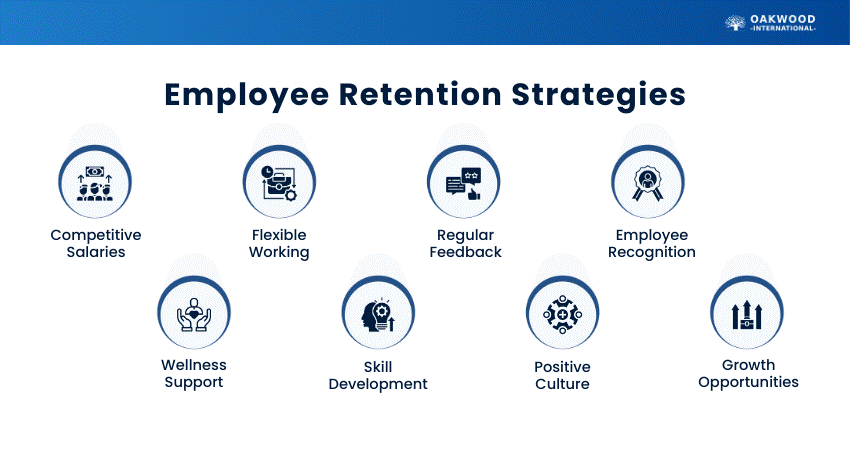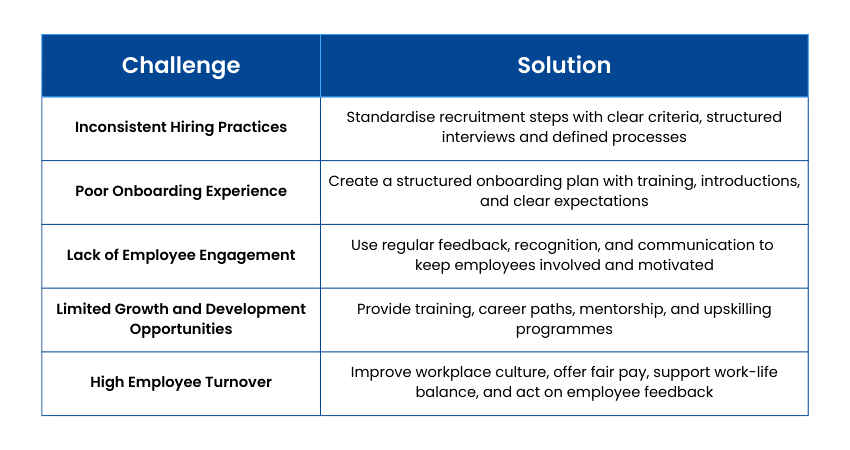Table of Contents


Remember the thrill of starting a new job? The welcome emails, the first team lunch, and the slightly awkward introductions all set the tone for how you view your new workplace. That experience isn’t just a one-off moment; it’s part of a much bigger journey known as the Employee Lifecycle from the first point of contact to the final day on the job.
When this journey is handled well, employees feel valued, engaged, and inspired to grow. But when it’s overlooked, even top talent can feel disconnected and drift away. In this blog, we’ll break down the seven key stages of the Employee Lifecycle and share simple, practical ways Human Resource (HR) teams can enhance each step for a more meaningful and rewarding experience.
What is the Employee Life Cycle?
The Employee Lifecycle is a model that shows the different steps an employee goes through while working for a company. These steps are: attraction, recruitment, onboarding, engagement, development, retention and separation.
Each stage plays an important role. If you take care of each one, your employees will feel supported, and your organisation will grow. This helps HR teams plan better and meet the needs of both the business and the employee.
Why Getting the Employee Life Cycle Right is Important?
When the Employee Lifecycle is done well, employees feel happy, valued, and motivated. This means they will stay longer, work better, and speak positively about the company. If the cycle is not managed properly, good employees may leave, and it becomes harder to find new ones.
A well-planned life cycle also helps HR understand what employees need at each stage. When you care about what your team feels, they become more loyal and bring better results to the company.
The 7 Stages of the Employee Life Cycle
The Employee Life Cycle includes seven key stages that shape an employee’s experience. Each stage plays a role in building a strong and lasting workplace journey.

Stage 1. Attraction
This is the first stage of the Employee Lifecycle stages, where potential employees first hear about your company. It’s all about building interest. People are more likely to apply if they see your organisation as a great place to work. Employer branding, social media, reviews, and word of mouth all play a part in attracting the right talent.
Example:
A marketing graduate sees a LinkedIn post about a company’s fun team culture and flexible working hours. She visits their website, reads employee testimonials, and becomes interested in working there even before applying.

How to Optimise the Attraction Stage
1) Show Your Values: Let people see what your company believes in and how you treat your employees.
2) Share Success Stories: Post real stories about your team and their work life.
3) Make Your Company Look Inviting: Use photos, videos, and honest words to show your workplace.
4) Use Referrals: Ask current employees to refer good people they know.
By doing these things, you attract people who share your company’s values and are excited to join.
Stage 2. Recruitment
Once someone is interested, the recruitment stage begins. This includes writing clear job ads, sorting applications, and holding interviews. The goal is to find the right fit for the job and the company. A smooth and fair recruitment process creates a good impression and helps you hire better people.
Example:
An IT firm posts a job opening for a Software Developer. The candidate applies, goes through a structured two-stage interview, and receives clear updates at every step. He feels respected and eager to join.
How to Optimise the Recruitment Stage
1) Write Clear Job Ads: Use simple language to explain what the job is about.
2) Use Fair Interviews: Ask similar questions to all candidates and check both skills and attitude.
3) Ask for Feedback: After interviews, ask candidates what went well and what can be better.
4) Involve the Team: Let current employees meet the candidate and share their views.
A good recruitment process helps you find the best people and gives a good impression of your organisation.
Stage 3. Onboarding
After hiring, it’s time to welcome the new employee. Onboarding is the process of helping them understand the company, their role, and how to do their job well. A strong onboarding experience helps employees feel settled, confident, and ready to contribute from the start.
Example:
A new HR assistant starts on Monday. On her first day, she receives a welcome kit, meets her team, and gets a clear schedule for training. By the end of the week, she feels confident and part of the team.
How to Optimise the Onboarding Stage
1) Start Early: Share key info and prepare their workspace before day one
2) Offer a Clear Orientation: Explain company values, policies, and how things work
3) Set Role Expectations: Clearly outline job duties and performance goals
4) Assign a Buddy or Mentor: Give them someone to guide and support them
5) Check in Regularly: Schedule quick chats to offer feedback and support
Good onboarding helps employees settle in quickly and feel comfortable in their new job.
Become a skilled learning leader with the CIPD Level 5 Associate Diploma in Organisational Learning and Development – Join now!
Stage 4. Engagement
Engaged employees are happy, productive, and loyal. This stage is about making sure people feel connected to their work. Recognition, regular feedback, open communication, and a positive culture all help employees stay motivated and involved in the company.
Example:
An employee feels heard because his feedback in a pulse survey leads to changes in team meetings. He’s also recognised for his work in a monthly spotlight and feels more connected to the company’s mission.

How to Optimise the Engagement Stage?
1) Encourage Regular Feedback: Let employees share their thoughts and feel heard
2) Recognise Achievements: Celebrate both individual and team success
3) Support Work-life Balance: Offer flexibility and personal well-being support
4) Create a Positive Environment: Build trust, respect, and teamwork
5) Offer Growth Opportunities: Support learning and career development
When employees feel engaged, they feel more like a part of the organisation and enjoy coming to work.
Stage 5. Development
Employees want to grow in their jobs. This stage focuses on training, learning new skills, and planning for future roles. Offering development opportunities shows that you care about your employees’ careers, which helps them stay longer and perform better.
Example:
A customer service employee wants to move into team leadership. The company provides regular training, a mentorship programme, and sets clear goals. Within a year, she’s been promoted and is leading her own team.
How to Optimise the Development Stage?
1) Identify Skill Gaps: Assess current competencies and determine areas for improvement.
2) Set Clear Goals: Collaborate with employees to establish achievable development objectives.
3) Offer Diverse Learning Opportunities: Provide access to workshops, courses, and on-the-job training.
4) Encourage Mentorship: Pair employees with mentors to guide their professional growth.
5) Monitor Progress: Regularly review development plans and adjust as needed to align with evolving goals.
A strong development culture helps employees feel valued and motivated to contribute their best. It also builds a future-ready workforce equipped to meet evolving business needs.
Stage 6. Retention
This stage is about keeping your best employees for the long term. Good pay, benefits, work-life balance, and chances to grow are all important. When employees sense they are valued and supported, they are more likely to stay and do their best work
.
Example:
A long-time finance officer is offered a chance to work part-time after returning from parental leave. The company also gives him access to wellness support and learning options. He decides to stay instead of looking elsewhere.
How to Optimise the Retention Stage ?
1) Offer Growth Opportunities: Provide clear paths for career development and skill-building.
2) Build a Positive Culture: Recognise achievements and encourage open, supportive communication.
3) Ensure Fair Compensation: Keep pay and benefits in line with market standards.
4) Support Work-life Balance: Offer flexible working options and wellness support.
5) Act on Employee Feedback: Use surveys or meetings to understand needs and make improvements.
Happy employees are more likely to stay and do great work for your organisation. Strong retention practices also reduce turnover costs and help maintain a stable, high-performing workforce.
Take your People Management expertise to the next level. Join our CIPD Level 7 Advanced Diploma in Strategic People Management now!
Stage 7. Separation
Eventually, employees leave whether to retire, switch jobs, or for other reasons. This stage should be handled with care. A proper exit process, including exit interviews and knowledge transfer, helps keep things professional. It also leaves the door open for future opportunities, such as rehiring or referrals.
Example:
A Senior Manager decides to retire after 15 years. HR arranges an exit interview, ensures a smooth handover, and holds a farewell lunch. She leaves with gratitude and recommends the company to others.
How to Optimise the Separation Stage ?
1) Exit Interviews: Collect honest feedback to learn and improve
2) Knowledge Handover: Ensure responsibilities are smoothly transferred
3) Handle Admin Tasks: Settle final pay, benefits, and equipment returns
4) Leave on Good Terms: Show respect and appreciation to parting employees
A good separation keeps your company’s reputation strong and leaves the door open for future connections.
Benefits of Using the Employee Life Cycle
Understanding What is the Employee Lifecycle model helps companies know what employees need at each step of their time with the business. When organisations support people properly from the moment they join until the day they leave, employees feel more motivated, happier, and more satisfied at work. This not only improves their experience but also brings important benefits to the business.
1) Lower Staff Turnover
1) Helps identify why employees leave and where improvements are needed
2) Supports consistent engagement, making employees more likely to stay long term
3) Strengthens recruitment processes by helping businesses hire the right people
4) Reduces the cost of frequent rehiring, onboarding, and training
5) Builds a stable workforce with stronger team relationships and continuity
2) Organisational Improvement
1) Highlights gaps or weak points across different stages of the employee journey
2) Improves HR processes through continuous evaluation and refinement
3) Enhances the employer brand, helping attract stronger talent
4) Creates a more supportive and structured environment for employees
5) Strengthens the company’s reputation as a great place to work
3) Increased Employee Engagement
1) Ensures employees feel valued at every stage of their journey
2) Encourages better communication between employees and management
3) Provides clarity on career progression, which boosts motivation
4) Helps organisations adapt strategies as employee needs change
5) Fosters a positive culture where employees feel connected to the company’s goals
4) Better Training and Development
1) Identifies when employees need new skills or upskilling opportunities
2) Ensures training is aligned with career goals and organisational priorities
3) Improves productivity by giving employees the tools they need to succeed
4) Encourages continuous learning, helping staff feel more confident and capable
5) Supports succession planning by preparing employees for future roles
Challenges and Solutions of the Employee Life Cycle
Managing the Employee Lifecycle can be challenging, as each stage requires the right processes, support and communication to keep employees engaged and motivated. Many businesses face similar problems, like slow hiring, poor onboarding, or not enough training. The table below shows common challenges and easy solutions to help improve employee experience.

Conclusion
A well-managed Employee Lifecycle creates a workplace where people feel valued, supported, and motivated. By improving each stage from hiring to exit, HR can build stronger teams, reduce turnover, and boost job satisfaction. When the employee journey is handled well, both employees and the organisation grow together and succeed. It all starts with understanding what truly matters to your people.
Begin your people profession path with a trusted qualification. Join our CIPD Level 3 Certificate in People Practice now!


 Back
Back



 Back to Catagories
Back to Catagories





 + 44 7452 122728
+ 44 7452 122728










